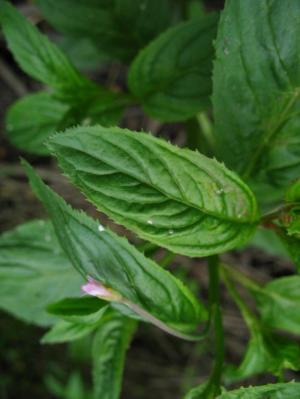Rosy willowherb
(Epilobium roseum)

Description
Epilobium roseum, commonly known as the rosy willowherb, is a species of herbaceous perennial plant belonging to the family Onagraceae. This plant is native to the northern hemisphere and can be found in North America, Europe, and Asia. The plant is known for its beautiful, pink flowers and is often grown in gardens for its ornamental value. Taxonomy and Nomenclature The scientific name of rosy willowherb is Epilobium roseum. It was first described by Carl Linnaeus in his book Species Plantarum in 1753. The genus name Epilobium is derived from the Greek words epi, meaning "upon," and lobos, meaning "pod," referring to the position of the flower on the stem. The specific epithet roseum refers to the pink color of the flowers. Description Epilobium roseum is a herbaceous perennial plant that can grow up to 1 meter tall. The stem of the plant is erect, with a reddish color and covered with fine hairs. The leaves of the plant are simple, alternate, lanceolate, and toothed. The leaves are also covered with fine hairs, giving them a grayish-green appearance. The flowers of the plant are pink and have four petals that are deeply notched. The flowers are arranged in a spike-like inflorescence at the top of the stem. The plant blooms from June to September. Overall, rosy willowherb has a delicate and graceful appearance, with its pink flowers and fine, softly hairy leaves and stem. Habitat and Distribution Epilobium roseum, or rosy willowherb, is native to the northern hemisphere and can be found in North America, Europe, and Asia. In North America, the plant can be found in Alaska, Canada, and the northern United States. In Europe, it is found in Norway, Sweden, Finland, Russia, and the Baltic states. In Asia, it is found in Siberia, Mongolia, and China. The plant grows in a variety of habitats, including open woods, meadows, wetlands, and along streams and rivers. It prefers moist soils and can tolerate some shade. In North America, it is commonly found in the tundra and boreal forest regions, while in Europe, it is found in subalpine and alpine meadows. In Asia, it is found in a variety of habitats, including mountainous regions, open woods, and meadows. Overall, rosy willowherb is a hardy plant that can grow in a wide range of habitats and growing conditions. Cultivation and Uses Epilobium roseum, or rosy willowherb, is often grown in gardens for its ornamental value. It is a hardy plant that can tolerate a wide range of growing conditions. It prefers moist soils but can tolerate some drought. The plant can be propagated by seeds or by dividing the rootstock. In addition to its ornamental value, rosy willowherb has been used for medicinal purposes. The plant contains tannins, flavonoids, and other compounds that have been shown to have anti-inflammatory, antimicrobial, and antioxidant properties. The plant has been used to treat a variety of ailments, including diarrhea, dysentery, and respiratory infections. Rosy willowherb has also been used in traditional medicine to treat prostate and urinary tract problems. Extracts from the plant have been shown to inhibit the growth of prostate cancer cells in vitro and in animal studies. However, more research is needed to determine the efficacy and safety of rosy willowherb as a treatment for prostate cancer in humans. Overall, rosy willowherb is a versatile plant with both ornamental and medicinal uses. It is easy to cultivate and can be a valuable addition to a garden or herbal medicine cabinet. However, it is important to consult with a healthcare professional before using rosy willowherb or any other herbal remedy for medicinal purposes. Conclusion Epilobium roseum, or rosy willowherb, is a beautiful and hardy plant that is native to the northern hemisphere. It is often grown in gardens for its ornamental value and has been used for medicinal purposes for centuries. The plant is easy to cultivate and can tolerate a wide range of growing conditions. Its anti-inflammatory, antimicrobial, and antioxidant properties make it a valuable addition to any herbal medicine cabinet.
Taxonomic tree:







